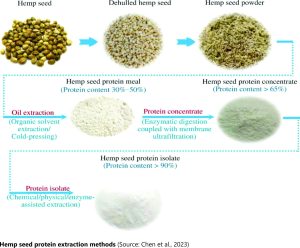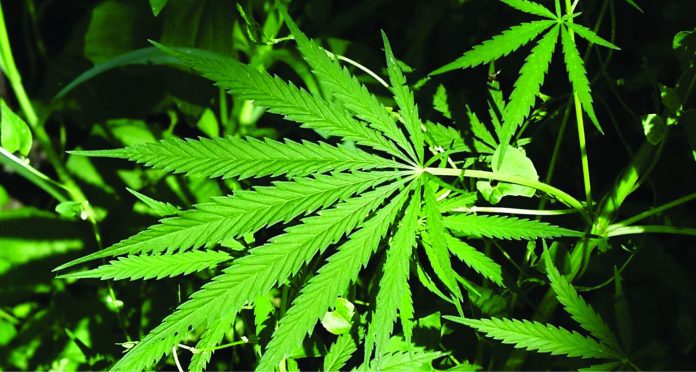

Traditional feedstuffs (fish meal and fish oil) are encountering sustainability difficulties as natural stocks diminish, prompting nutritional research into alternatives. Because of its sustainable production and impressive nutritional characteristics, hemp seed meal has shown promise as an alternative feed ingredient in aquaculture.
Hemp
Hemp (Cannabis sativa), a member of the Cannabaceae family, is an annual plant native to Central Asia. It has long been valued for its medical properties and textile applications. The seeds are brown with deeper brown streaks and measure 2.5-3.5 mm in length. Although the high levels of tetrahydrocannabinol (THC) in hemp seeds are responsible for central nervous system depression, which hampered the widespread use of hemp in the food industry, the production of industrial hemp with a THC level of less than 0.3% facilitated the commercialization of hemp-based foods in China, Canada, and several other countries. In fact, China leads the industry, supplying half of the world’s industrial hemp, followed by Canada, Chile, France, and Spain. They have been utilized in medicine and food homology, due to their high nutritional value. Furthermore, hemp plants are pest and disease-resistant, and apart from that, they contribute to the reduction of greenhouse emissions in the atmosphere.


The digestibility of hemp seed isolate protein was found to be equivalent to that of soybean protein isolates for pepsin digestion, whereas digestibility (88-91%) was significantly greater than that of soybean protein isolates (71%) for pepsin + trypsin digestion.
Hemp seed oil has an ideal ratio of Omega-3 alpha-linolenic acid (ALA) and Omega-6 linoleic acid. It is lower in saturated fatty acids than other similar oils and is a more sustainable choice because it is extracted from a plant that uses little water and captures as much as 8 times more carbon than a majority of trees.
Hemp in Animal Diets
Aqua – Sample (2022) discovered that in striped bass diets, up to 50% of fish meal can be replaced with hemp seed meal without impacting growth or digestibility.
Poultry – The hemp seed meal had a 5:1 ratio of Omega-6 (linoleic plus γ-linolenic acid) to Omega-3 (α-linolenic) fatty acids. Adding hemp seed meal to laying hens’ diets reduced the percentage of palmitic acid in the yolk while increasing the percentages of linoleic and α-linolenic acids(Silversides et al., 2002).
Dairy – Hempseed cake was used as a protein feed instead of soybean meal in intensively fed developing calves, and it resulted in equal weight gain and carcass characteristics, as well as enhanced rumen function, due to the increased fiber content of hemp seed cake compared to soybean meal (Eriksson, 2007).
Legality and Viability
India – Uttarakhand became the first Indian state to legalize hemp production in July 2018. Obviously, it is now India’s largest hemp producer. Hemp seed and its products have lately been recognized as food or food ingredients by the FSSAI.
Furthermore, the FSSAI’s recent notification supports the Uttarakhand government’s intention to reinterpret its industrial hemp policy and award India’s first hemp-growing license. To expand the scale and scope of the hemp business, the State Government supports a number of Self-help groups and farmer groups using a purchasing power parity strategy.
The Centre for Aromatic Plants, Selaqui, Dehradun, has been designated as a nodal agency for industrial hemp cultivation.
UK – Following an
investigation of the impact of hemp protein on the health and welfare of farmed Atlantic salmon in Scotland, a team of UK researchers (University of Stirling’s Institute of Aquaculture and Scottish Aquaculture Innovation Centre) plans to employ hemp seed as a sustainable source of protein for Scottish salmon feeds. Rare Earth Global, a grower of industrial hemp for a variety of sustainable products, is the organization driving the program. The findings of this study may result in the first use of hemp as an aquafeed ingredient.
USA – Along with the legalization of hemp as an agricultural crop in the United States, there is a rising movement to incorporate hemp byproducts into cattle diets as a viable feedstuff. Many studies have found hempseed cake to be highly nutritious and a feasible alternative feed option for cattle due to its high protein and fat content. A pro-hemp organization in the United States has applied to the Food and Drug Administration (FDA) to investigate the use of hemp in fish and other animal feeds.
China has a century-long tradition of hemp cultivation and is the world’s largest producer of hemp seeds. It was reported as one of the five grains of ancient China and has been used as human food and animal feed for more than 3,000 years. The Chinese hemp business is gathering steam, with a special emphasis on two major markets: textiles and well-being. Because of its health benefits, hempseed is still a favorite snack among people in Yunnan, Guangxi, and Xinjiang.
South East Asia-Thailand became the first country in Southeast Asia to fully legalize the use of cannabis for food-related purposes in July 2022.
South Africa- The Department of Agriculture, Land Reform, and Rural Development issued amendments in October 2021 to obtain a Hemp Permit from the Department to import, export, grow, and market hemp.
Australia – Hemp is a new crop in Australia, and its potential as an animal feed has yet to be completely realized. The Australia New Zealand Food Standards Code was revised to permit the sale of food made from low-delta 9-THC hemp in Australia and New Zealand. These changes went into effect on November 12, 2017.
Conclusion
There is still a lack of understanding about the distinctions between industrial hemp and drug hemp. As a result, further basic and applied research on the potential benefits and applications of hemp seed is required to fully exploit the competitive advantages of hemp seed protein and oil in the aqua feed sector.
References available on request














